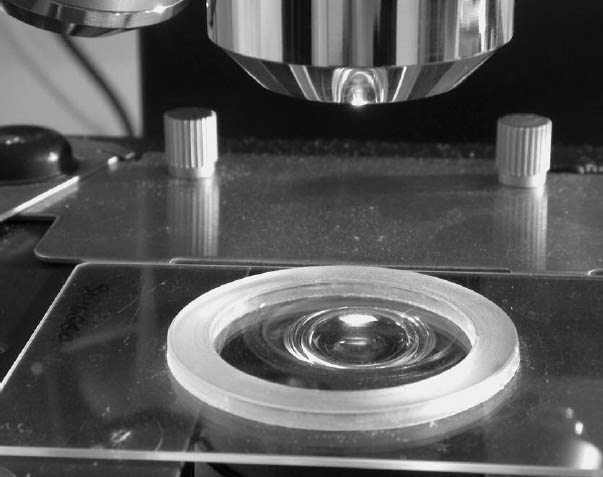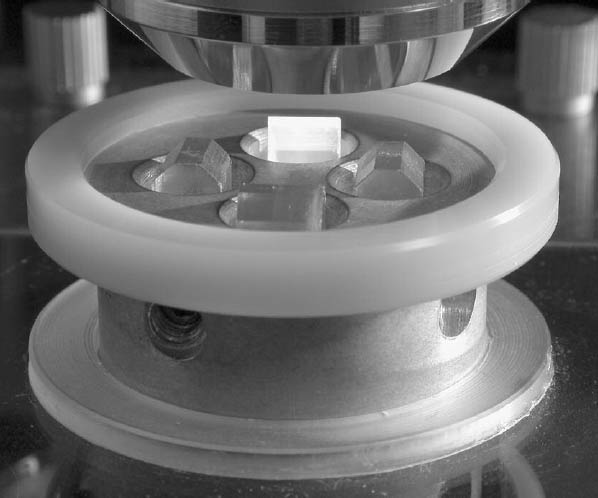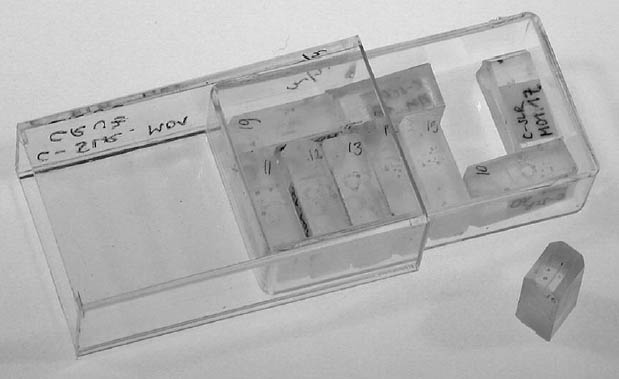EFFICIENT NEW METHODS FOR EMBEDDING PAINT AND VARNISH SAMPLES FOR MICROSCOPYMELVIN J. WACHOWIAK
6 SUMMARY: TOWARD A STANDARD FOR EMBEDDING?The most time-intensive step of analysis of paint and varnish cross sections may be revealing the microstructure of the coatings and substrates. In conservation, samples are typically prepared by abrasive polishing, and often in nonuniformly shaped matrices such as truncated pyramids from cocktail ice cube trays. These difficult-to-hold shapes must be prepared one at a time. The variable shapes often force the analyst to adjust the prepared sample's orientation along three axes, supported in clay, which prevents the use of transmitted light. A standard form or matrix for embedding would allow efficient preparation, examination, and documentation of many samples. Although sample preparation and protocols exist in biology and materials science, they are not immediately applicable. While the methods for embedding samples in use for over a half-century do indeed work, this article describes improvements in format efficiency, materials, and production of high-quality results.
This article also describes a new resin and two embedding procedures, as well as a holder for simultaneous preparation of multiple samples. Fixtures in the form of aluminum holders or mold-formed discs produce a surface that is parallel to the optical axis of the microscope as well as flat across the surface within microns. This feature allows the analyst to confidently prepare large numbers of very small samples and to concentrate on interpretation and documentation of structure. The methods are also easily learned and are applicable to machine or hand polishing. The methods and materials are effective for preparation of cross sections of coating samples, but broader application to other materials should be apparent. Minor revisions to the mounting procedure will enable the analyst to produce parallel, angled, wedge, and serial sections. Applications can include other materials that are degraded or solvent sensitive, water-soluble materials, and samples such as films, yarns, and fibers. Even though samples embedded nearly 10 years ago show no noticeable flaws, this assurance is not enough. In the future, long-term and accelerated aging of Tra-Bond should be undertaken. Not all epoxies age well. Microtomy of Tra-Bond 2113 has not been attempted. Other epoxies have interesting properties, such as the related Tra-Bond 2112 and lower-viscosity F113. Other volatile lubricants could be tested, or cleaning procedures could be developed to remove polishing residues. A case can be made for evaluation of these and other current methods, as well as previous methods and materials, to determine whether a standard method is desirable. Standardization should also increase the utility of samples, which can then be confidently reexamined in the future or even exchanged among analysts as part of a large study. While a general method may work most of the time, there is certainly a place in conservation practice for several techniques. In some cases, a wax embedding may be more suitable than epoxy resin. Grinding and polishing work well for many types of material, but the microtome has advantages in the preparation of new or modern varnishes. Control of our methods and materials will enable better description of the sample, repeatable success, and the ability to trace a fault to its source. The methods described above have worked well with a wide range of material, from ethnographic to fine art and architecture, ancient and modern, and using a variety of optical techniques.
|



